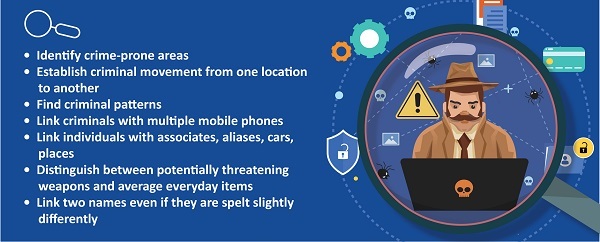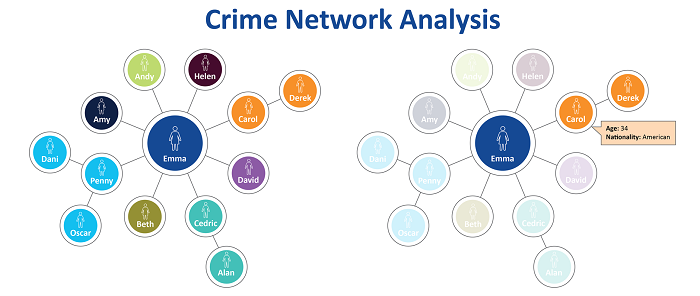Posted by:
Kannan Jayaraman
Publish Date:
11 Oct, 2021
Most UK police forces are successfully using digital visualisation capabilities to examine links – between two people or to differentiate between a person with a phone or a gun, perhaps, and much more. Visualising those links as a network or on a timeline can help identify risks and solve crimes, and the outputs are also often used in court trials. But there’s a lot more that police forces can do with digital capabilities to help them enforce the law better.
How can digital and data-driven capabilities boost the Digital Policing agenda for the UK Police 2025 Vision?
Today, most police forces’ digital use is limited because they are unable to apply it to their full range of data. Data fragmentation is a common source of frustration because forces often have all the data they need to solve a crime, but can’t organise that data without lots of manual effort.
In addition, data used in current tasks isn’t always up to date and can’t be presented as flexibly as police forces may want. There are tools to improve presentation, but integration can be complex, particularly if the police force hasn’t already adopted advanced digital capabilities.
All in all, police forces are right to feel that they aren’t yet getting the full potential return from their investment in digital – or in data.
Benefits of data-driven digital capabilities for digital policing vision

There are a range of options for getting more out of your data captured, with the ability to gain a more comprehensive view of crimes and risks, then find patterns in the information and extrapolate from them. This way, you can understand the past better and predict the future with more confidence. You can present information in a range of ways, from networks to timelines to dashboards.
To see the value this could bring, let’s consider an investigation of a drug-dealing gang. Typically, it takes weeks or even months to establish who’s involved and where they’re active. But with digital and machine learning techniques, your officers could explore patterns in data that is already there to link individuals with associates, aliases, cars, places and more, to quickly build a picture of how the gang operates, without leaving the station.

Social Network Analysis of criminals/gangs using AI and Machine Learning digital capabilities
You can use digital information to overcome problems such as criminals frequently switching off mobile phones. With digitisation, it can be easy to link one individual to all their phones so that a suspect can still be tracked, no matter how often they throw it away.
Once you have the ability to link items together and recognise patterns, you can add complementary tools that enable you to make predictions. For example, you can identify areas where crimes may occur and increase police patrols there. You can also predict where criminals like drug dealers will go next if police intervene in their preferred area.
Using digital information to identify patterns can also validate that your resources are being allocated following the right priorities and in line with your force’s Strategic Intelligence Assessment.
InvenioLSI can help you take your digital use to the next level
So, enhancing your use of digital positions you to work more effectively, solve and prevent more crimes, and get more return on your existing investment.
The main steps in applying digital to your chosen challenges are to:
- Start with a hypothesis – use case, e.g., how to determine the priority of focus for police resources/investments and policy decisions based on data.
- Link a broader range of data sets to digital to get a more comprehensive view and ensure all data is in real-time.
Complement your digital capabilities
A tool that brings great benefit when used in conjunction with digital is InvenioLSI’s Assurance Scoring Platform (ASP). This is your number one asset in improving the way you allocate resources. It uses advanced analytics to identify cases that need straightforward handling or pose a negligible risk – which can be as many as 90% of the total caseload. With straightforward cases out of the way, you can focus your use of digital analysis on problematic cases needing advanced investigation using digital and other analytic tools. This way, you optimise the focus of investigations, make the best use of your resources, and drive the force’s chosen priorities.
Artificial Intelligence (AI) tools to help with recognising links and patterns can also complement your digital strategy. By integrating this intelligence, you can enrich digital with additional capabilities such as “fuzzy matching” - which enables you to tentatively link two names even if they are spelt slightly differently.
Why work with InvenioLSI?
InvenioLSI is your ideal partner as we are a specialist organisation, with extensive experience in working with local governments and other public sector organisations to make the most out of their data and resources.
For one major government department, we recently helped to create a central function that delivers data analytics to service business requirements. We brought together multiple data sources that were not previously easily accessible. Assurance Scoring Platform has been introduced to enable the organisation to focus on the most challenging cases. We initially built a specific analytics capability for one part of the organisation, and this is now being widened and industrialised to meet the entire organisation's needs.
We are specialists in helping organisations rapidly assimilate, integrate and analyse data and turn its insights to inform crucial decisions and actions. We’ll work with you whichever way you prefer to identify the data and tools to help you get the most out of your insights, then integrate them in the way that works for your force.
Next steps
The first step in getting more out of digitisation is to think about your priorities. For example, your police force may have decided to focus on certain types of crime for the next 12 months. We can help you go through your priorities and see where a digital-based approach can help.
(And, as noted earlier, digital tools can also help you evaluate your policies, seeing if they’re the right ones and to what extent you’re achieving them.)
Having identified an area you’d like to tackle, we can work together on a proof of concept (POC) that will show the value to be added to that area. The POC will be built in just six to eight weeks by two or three people - a live tool that you can use to run your force better.
This way, you start small – for example, integrate as few as two data sources – and can scale up later once you understand more about what can be achieved and the value it brings.